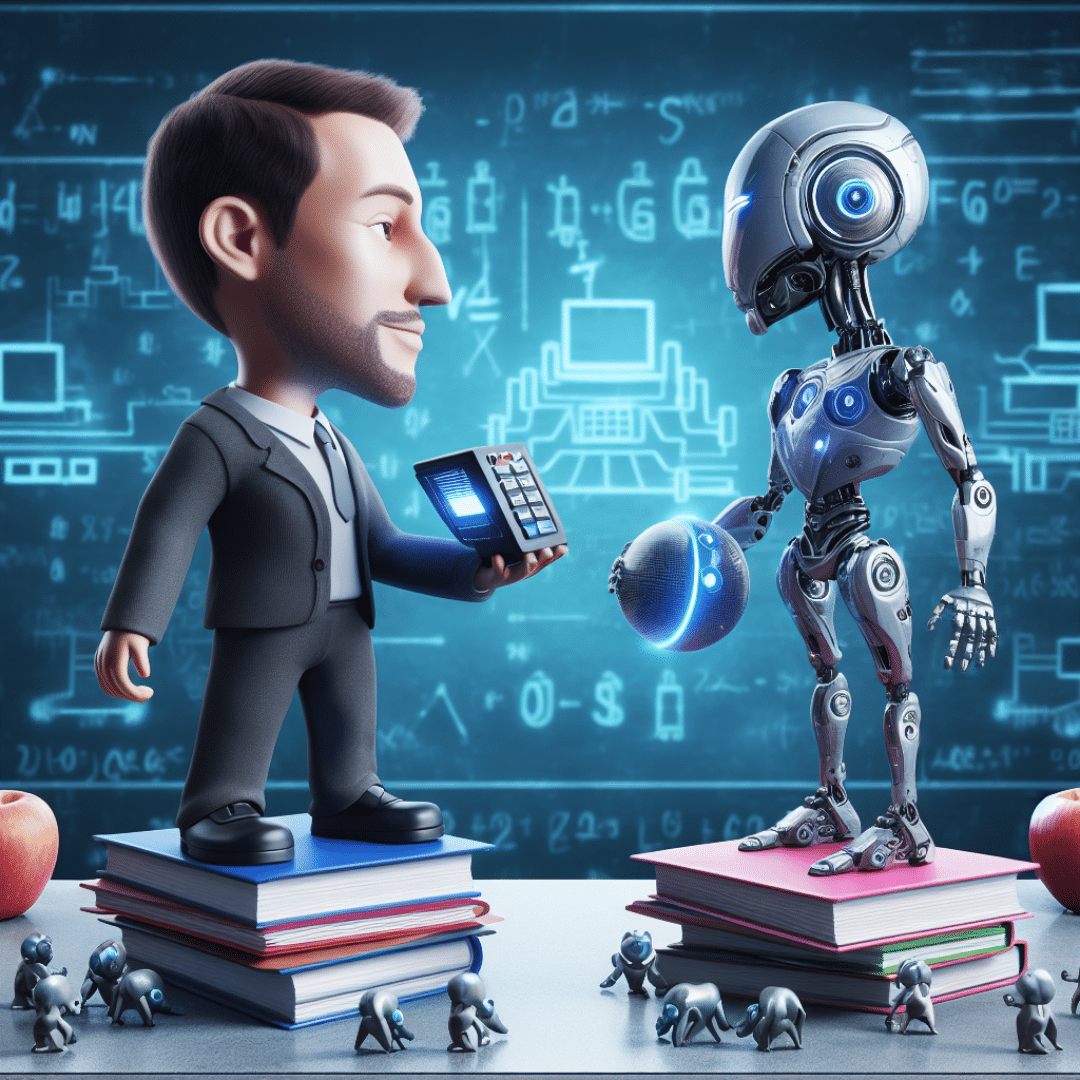November 12, 2023
In an era where technological advancements are reshaping the landscape of virtually every industry, the role of Artificial Intelligence (AI) in education stands out as both promising and contentious. The mere mention of AI often triggers a spectrum of emotions, from awe-inspired enthusiasm to deep-seated fear. As we embark on this exploration, it’s crucial to dispel the shadows of misconception and recognize that, contrary to popular belief, AI is not the enemy.

Education, the cornerstone of societal progress, is experiencing a paradigm shift driven by AI innovations. I want to seek to unravel the potential of AI as a formidable ally in the realm of learning. I’ll delve into the collaborative synergy between AI and educators, the transformative power of personalized learning, and the ways in which AI is breaking barriers to education access. I hope to dismantle the fears surrounding AI, as we discover its pivotal role in shaping a more inclusive, engaging, and effective educational landscape.
The Collaborative Classroom
Imagine a classroom where AI is seen as a collaborative partner in the work of educating students. AI has incredible potential to improve learning. For example, AI can be a powerful tool for personalized learning. Often, when we think of AI we all jump to ChatGPT, but ChatGPT is the baby in a long line of AI powered tools, for example, adaptive learning platforms have been in use for 20 years or more. “Adaptive learning is a personalized strategy that’s especially valuable in environments with diverse learners, such as classrooms or online courses. Here, you can tailor your learner’s individual learning experience to their needs and progress, and make sure they can grasp the material thoroughly and effectively. This type of learning technology uses data and algorithms to analyze a learner’s performance, strengths, and areas that need improvement. The learning content and activities are adjusted in real-time to match the learner’s pace and level of understanding. That means it can generate more challenging content when they excel and offer additional support or review when they struggle” (Small 2023). There are numerous adaptive learning platforms, but here are a few examples: EdApp, Adaptemy, Knewton, CogBooks, Realizeit, Smart Sparrow, and Pearson Interactive Labs.
Other applications like Rewordify, a free, online software that effectively simplifies difficult texts so readers at any level can participate in the learning, or PowerPoint Speaker Coach, which evaluates your pacing, pitch, your use of filler words, informal speech, euphemisms, and culturally sensitive terms, and it detects when you’re being overly wordy or are simply reading the text on a slide and after rehearsing provides you with a report that includes statistics and suggestions for improvements, can also be used to tailor learning to a student’s individual needs.
In these examples, AI works as a collaborative partner with the educator and should be seen as a means of augmenting, not replacing, the teacher. I like how Reuben Thiessen from the Stanford Graduate School of Education encapsulates the use of AI down to the Three Ds: Dreaming, Drudgery, and Design.
Three D’s
- Dreaming
- Definition: Helping you think
- Examples: Brainstorming, Concept expansion, Concept mapping, Collaborative Writing, Scenario building, Simulating discussions
- Drudgery
- Definition: Lightening your load
- Examples: Summarization, Data Cleansing, Progress Tracking, Content Moderation, Synthetic Data, Review and Feedback
- Design
- Definition: Building your content
- Examples: Lesson Plan Generation, Project Planning, Content Personalization, Accessibility Design, Interactive Experiences, Curriculum Mapping
As you can see from Thiessen’s Three Ds, there are countless ways AI can be effectively used to support educators thus enabling them to have more time to focus on their students; Administrative Assistant AI at your service.
Breaking Barriers in Education
Artificial Intelligence is making significant strides in breaking barriers in education, revolutionizing the way we approach learning and access to knowledge. One of its most impactful contributions is bridging the gap in access to education. Through online learning platforms and remote education facilitated by AI, students from diverse backgrounds can now access educational resources and opportunities that were once limited by geographical constraints. This digital transformation has opened up a world of possibilities for learners who may have otherwise struggled to receive a quality education.
Moreover, AI is playing a crucial role in providing resources for underprivileged students. By tailoring educational content to the specific needs and requirements of different learners, AI ensures that those with limited access to traditional learning materials can still benefit from a robust educational experience. This fosters inclusivity and equalizes educational opportunities, creating a more level playing field for students regardless of their socio-economic backgrounds.
In the realm of inclusive learning environments, AI acts as a facilitator by adapting to the unique needs of each learner. Through personalized and customized learning experiences, AI helps create a more inclusive educational landscape. Whether it’s through adaptive learning platforms, virtual tutors, or interactive simulations, AI helps educators customize the learning experience to match the diverse needs of their students. This adaptability ensures that students with different abilities, learning speeds, and preferences can engage with the material in a way that suits them best. Furthermore, it not only enhances the learning process but also encourages a more comprehensive understanding of the subject matter. In essence, AI is transforming education into a dynamic and responsive system that caters to the individual needs of each learner.
AI is breaking barriers in education by fostering inclusivity, providing resources for the underprivileged, and creating customized learning experiences. As technology continues to advance, the potential for AI to positively impact education and create a more equitable learning environment becomes even more promising.
AI and Student Engagement
AI has become a game-changer in the realm of student engagement, introducing innovative approaches like gamification and interactive learning. These methods leverage AI algorithms to create dynamic and captivating educational experiences. Gamification, for instance, incorporates elements of game design into the learning process, turning lessons into interactive challenges that foster healthy competition and collaboration. “As per research conducted by schools in Bangalore it has become the most impactful way of teaching as it builds independent learning habits and dilutes geographical barriers. Gamification and Artificial intelligence as methods of teaching are taking lead” (Amitsati 2023). One notable example of gamification AI in action is Duolingo, a popular app for learning languages. The possibilities for AI and gamification are not only limited to learning languages. Richard Smith, in his article “Gamification and AI: The 2030 Vision of Engaged Learning and Productivity” outlines the many ways AI and gamification can be used including interactive journeys and immersive Ar and VR experiences. Using AI in gamifiying the learning experience not only enhances motivation and interest but also transforms education into a more enjoyable and engaging journey.
Through AI-driven activities, students can develop a love for learning as they interact with personalized content tailored to their individual needs and preferences. The adaptive nature of AI ensures that the material is not too easy or too difficult, maintaining an optimal level of challenge for each student. An excellent example of this is action is NewsELA which provides authentic, engaging content that is automatically differentiated at five reading levels. The adaptive technology scaffolds lessons to be more accessible for striving readers or to challenge high fliers and increases difficulty over time as students improve.
Real-time feedback is another invaluable feature, providing immediate assessments and constructive criticism. AI Coach is a great example of instant feedback in action. Using OpenAI, AI Coach can give feedback, suggest improvements, and mark questions as complete based on the learner’s response. This type of real-time feedback not only accelerates the learning process but also instills a sense of continuous improvement and resilience in students, nurturing a growth mindset that is crucial for success in any field.
Digital literacy has become a cornerstone in the age of AI, encompassing the understanding of algorithms and their impact on various aspects of our lives. Digital literacy in the age of AI refers to the ability to use, understand, and critically evaluate information and technology in a world increasingly shaped by artificial intelligence. It involves not just basic computer skills but also a deep understanding of how AI systems work, their implications for society, and the ability to navigate and interact with digital tools effectively. Being digitally literate in the age of AI means being able to adapt to new technologies, discern reliable information from the vast sea of data, and participate thoughtfully in the digital landscape. Integrating digital literacy into the curriculum is essential for preparing students for a tech-driven future, ensuring they are equipped with the necessary skills to thrive in a digital landscape.
Addressing Concerns and Ethics
However, as we embrace the benefits of AI in education, it’s crucial to address ethical considerations. Educators must play a pivotal role in teaching responsible AI practices and nurturing a sense of digital ethics and responsibility among students. This involves not only understanding the ethical implications of AI but also instilling a commitment to using technology in ways that benefit society as a whole. By emphasizing these principles, we can ensure that the integration of AI in education aligns with ethical standards and contributes positively to the development of responsible and conscientious digital citizens.
Mark Anderson and Laura Knight developed a policy template to aid in creating an Artificial Intelligence Policy, a worthwhile endeavour to aid and support digital ethics and responsibility in educational settings.
Transparency in AI algorithms is a key principle, ensuring that the inner workings of these systems are open and understandable. This transparency not only builds confidence but also allows for scrutiny and identification of potential biases. Speaking of biases, it’s imperative to focus on ensuring fairness and implementing effective bias mitigation strategies. Open discussions about ethical considerations are essential in navigating the complex landscape of AI, involving diverse perspectives to make informed decisions. Barbara Anna Zielonka has thought deeply about these open discussions and has done extensive work developing AI Advisory boards, an initiative “with the aim of actively involving students in discussions about the application of artificial intelligence (AI) in education. This initiative serves a dual purpose: first, to empower students by giving them a voice in shaping the use of AI in their educational experiences, and second, to demonstrate the transformative potential of AI technology in the field of education” (Zielonka 2023). This sort of initiative can lead the way in developing and promoting conversations around the ethical considerations regarding the use of AI.
Data privacy and security are paramount in the ethical deployment of AI. Safeguarding sensitive information, especially in educational settings, is vital. This includes implementing robust security measures to prevent unauthorized access and potential breaches. By prioritizing these ethical considerations, we can create a foundation for AI that respects privacy, upholds fairness, and addresses concerns, ultimately contributing to the responsible advancement of technology.
Case Studies and Success Stories
There have been numerous studies looking at the use of AI in the classroom showing positive results. Let’s dive into a few compelling case studies and success stories that showcase the positive impact of AI in education. Nikita Verma outlines ten examples in their article “How Effective is AI in Education? 10 Case Studies and Examples”. I have highlighted a few of those here:
A Stanford study tested a machine-learning program that would predict when a student was likely to get stuck and start “wheel-spinning”, at which point it would recommend a relevant solution. The program was able to predict whether a child would fall into “wheel-spinning”, even before they had begun a new lesson. In four out of the six cases, the model and the human expert came up with the same recommendations. The study concludes that AI can be used to identify student problems and make it easier for a limited number of human teachers to help a large number of students.
The University of Murcia in Spain recently implemented an AI-powered chatbot to assist students with inquiries about the campus and academic programs. To the surprise of administrators, the chatbot demonstrated a high level of proficiency, answering over 38,708 questions correctly more than 91% of the time. Keep in mind, this was before ChatGPT, and we can only expect these metrics to improve even further.
Pai et al. (2020) proposed an intelligent tutoring system to help fifth-grade students learn the mathematical unit of multiplication and division. They found that the intelligent tutoring system (ITS) improved students’ mathematics learning performance and increased their learning motivation. In fact, it showed that students’ grades improved by 30% while reducing their anxiety by 20%.
At the Georgia Institute of Technology, Jill Watson, an AI-powered chatbot developed by IBM’s Watson, had a 97% accuracy rate and was able to respond to approximately 10,000 student inquiries each semester with remarkable human-like efficiency.
Edwin is an AI-powered service for learning English as a foreign language. Using adaptive learning technology, Edwin’s team built English test preparation courses that were taught by a Facebook chatbot and a human teacher in tandem. Over 800,000 students have improved their English with Edwin.
Gradescope, a platform designed to streamline the grading process, delivering benefits to both educators and students, was shown to reduce the amount of time teachers spent on grading by 70%. The platform operates by allowing students to upload their assignments, which are then sorted and grouped by Gradescope. Educators have access to per-question and per-rubric statistics, providing valuable insights into student performance.
A study by Knewton, an adaptive learning company, found that students using their AI-powered adaptive learning program improved their test scores by 62% compared to students who did not use the program. The program provided personalized feedback and instruction to students, tailoring the learning experience to their individual needs and abilities.
These case studies underscore the transformative potential of AI in education, demonstrating its ability to individualize learning experiences, boost academic performance, and enhance student engagement and satisfaction. As technology continues to advance, we can expect more educational institutions to leverage AI to create dynamic and personalized learning environments for students around the world.
RECOMMENDED: https://global-edtech.com/category/lynn-thomas/
Looking Forward
The landscape of AI in education is undergoing a dynamic transformation, marked by the continuous evolution of AI technologies. Machine learning algorithms are increasingly tailored to adapt to individual learning styles, providing personalized learning experiences. Virtual tutors and AI-driven educational platforms are becoming more sophisticated, offering real-time feedback and assessment. As we look to the future, the potential developments in AI and education hold promising implications. The integration of AI could lead to a more inclusive and accessible education system, breaking down barriers for learners with diverse needs. However, ethical considerations and the responsible use of AI must be at the forefront of these advancements to ensure privacy, fairness, and transparency. Striking the right balance between technological innovation and ethical practices will shape the future of AI in education, influencing how we learn and teach in the years to come.
In conclusion, it’s evident that AI is not the enemy, especially when we consider its remarkable positive impact on education. From personalized learning experiences to efficient administrative tasks, AI has revolutionized the way we approach education. However, it’s crucial to maintain a balanced perspective, acknowledging the potential challenges and ethical considerations that may arise. As we continue to explore AI’s role in education, let’s strive for a harmonious integration, leveraging its strengths to enhance the learning experience while remaining vigilant and proactive in addressing any potential drawbacks. Embracing a thoughtful and informed approach will undoubtedly pave the way for a future where AI and education work hand in hand for the benefit of all.














